Let’s Export Our Deflation - All Japan, All the Time
Economics / Deflation May 19, 2013 - 06:33 PM GMTBy: John_Mauldin
 The evils of this deluge of paper money are not to be removed until our citizens are generally and radically instructed in their cause and consequences, and silence by their authority the interested clamors and sophistry of speculating, shaving, and banking institutions. Till then we must be content to return, quo ad hoc, to the savage state, to recur to barter in the exchange of our property, for want of a stable, common measure of value, that now in use being less fixed than the beads and wampum of the Indian, and to deliver up our citizens, their property and their labor, passive victims to the swindling tricks of bankers and mountebankers. –Thomas Jefferson, in a letter to John Adams, 21 March 1819
The evils of this deluge of paper money are not to be removed until our citizens are generally and radically instructed in their cause and consequences, and silence by their authority the interested clamors and sophistry of speculating, shaving, and banking institutions. Till then we must be content to return, quo ad hoc, to the savage state, to recur to barter in the exchange of our property, for want of a stable, common measure of value, that now in use being less fixed than the beads and wampum of the Indian, and to deliver up our citizens, their property and their labor, passive victims to the swindling tricks of bankers and mountebankers. –Thomas Jefferson, in a letter to John Adams, 21 March 1819
I am definitely bullish. The budget deficit is shrinking massively. Guys who are short, they better have a shovel to get out of the grave.
–David Tepper, Appaloosa Management LP, CNBC, 14 May 2013
Never have investors reached so high in price for so low a return. Never have investors stooped so low for so much risk.
–Bill Gross, PIMCO, 14 May 2013
We can rightly declare victory on the housing front and (reduce) our purchases, with the aim of eliminating them entirely as the year wears on. I believe the efficacy of continued purchases is questionable.
–Richard Fisher, president of the Dallas Federal Reserve Bank, National Association for Business Economics, 16 May 2013
It will take further gains to convince me that the "substantial improvement" test for ending our asset purchases has been met…. We could reduce somewhat the pace of our securities purchases, perhaps as early as this summer. Then, if all goes as hoped, we could end the purchase program sometime late this year.
–John Williams, president of the Federal Reserve Bank of San Francisco, Reuters, 16 May 2013
The balance of risks of prolonged very low interest rates and unconventional policies is shifting. The costs are growing in relation to the benefits.
–BIS, Reuters, FT Alphaville, 16 May 2013
Jefferson was lamenting the woeful state of the dollar 200 years ago because the country was beset by fiscal problems, not because someone in the government wanted to ruin the value of the currency. Today, however, we find ourselves in a situation where it is the national policy of multiple countries, including the United States, to reduce the value of their currencies. My friend Mohamed El-Erian chided me on stage at our recent conference not to say “currency wars” but to use the more polite term “currency tensions.” But no matter what you call it, there are clearly governments whose intent is to pursue a mercantilist trade policy to the detriment of their trade partners by manipulating the value of their currencies.
I predicted in Endgame that the latter half of this decade would see the most serious currency wars since the end of WWII. The opening shots have been fired. This will not be just a continuation of the currency skirmishes we have seen in recent decades. No, the real artillery is being brought to the front. And as in any war, it is best not to have your valuable personal possessions anywhere near the field of conflict. But which way to run? Who are the good guys to run to? Are there any good guys at all? Maybe the better question to ask is, who will win? Will there be any winners? Do you really want to look like Rocky Balboa after his first winning fight?
This week we again focus on Japan. Their stock market has been on a tear, and their economy grew 3.5% last quarter. Is Abenomics really the answer to all their problems? Is it just a matter of turning the monetary dial a little higher and voila, there is growth? Why doesn’t everyone try that? And what would happen if they did?
But first, since we are talking about Japan, let me remind readers about a very special webinar with one of my personal-favorite money managers, Kyle Bass of Hayman Capital Management, LP, based here in Dallas. On May 29, I will be calling in from Brussels to team up with Jon Sundt of Altegris Investments to talk with Kyle about his thoughts on all things economic, but in particular his latest views on what is happening in Japan. He will have just returned from Asia and will be full of new facts and ideas (as he always is). Kyle has always positioned his fund to take advantage of what he sees as potential risks in global markets (the subprime crisis, Europe, etc.), and now he has really laser-honed in on Japan. Given that I think (as I will make the case today) that Japan is now the center of monetary experimentation (and potential fiscal earthquakes), we must pay close attention.
If you are a qualified purchaser or a licensed investment adviser qualified to make private placement recommendations, please join my partners at Altegris for this webinar event on Wednesday, May 29, at 12:00 noon EDT/9 a.m. PDT. If you are not yet a Mauldin Circle member, be sure to register here for this lively and candid discussion. Upon qualification by my partners at Altegris, you will receive an email invitation. Existing Mauldin Circle members will automatically receive an invitation. I apologize for limiting this discussion to qualified purchasers and investment advisers, but we must follow the rules and regulations. I look forward to having you at this exclusive event. (In this regard, I am president and a registered representative of Millennium Wave Securities, LLC, member FINRA.)
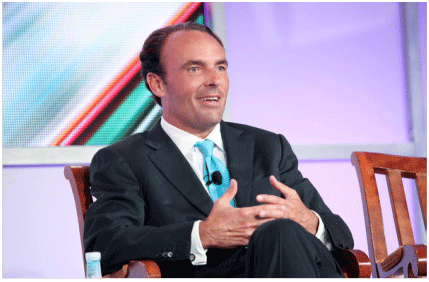
And now let’s focus on Japan.
Japan grew at a 3.5% annual pace last quarter, the fastest pace in a very long time. Of course, government officials see this development as vindication of their new policies and will no doubt decide that even more of the same will be needed in the future.
Retail sales in Japan are soaring as a “wealth shock” electrifies the economy. The Nikkei index has risen 70% since November, with foreign hedge funds among the first to jump on the bandwagon. The chart below provides some perspective on that rise. I can see several similar moves in the past 20 years. If this were a one-year rather than a 30-year chart, would everyone be so eager? I'm not saying that the move isn’t real. A lot of money has been made, at least on paper.
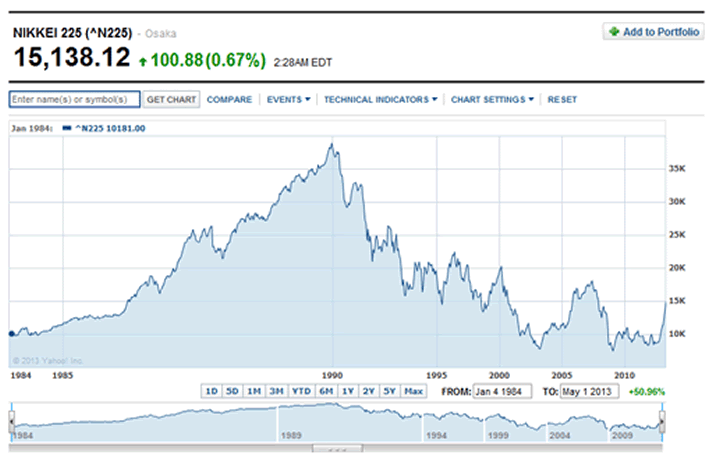
The weaker yen is already delivering a powerful punch, accounting for almost half the growth in the recent quarter. The currency has dropped 30% against the dollar and against China’s yuan since August, and 37% against the euro. This causes Ambrose Evans-Pritchard over in London to worry:
The yen-slide – or "Enyasu" – has raised concerns that Japan is exporting deflation through a "beggar-thy-neighbour" push for export share, a claim rejected by Tokyo.
Stephanie Kretz from Lombard Odier said the falling yen looks like a replay of the mid-1990s before the onset of the East Asian crisis, when external funding dried up in a "sudden stop".
It poses a direct threat to Malaysia, Vietnam, Thailand, Korea and others with a high trade gearing, as well as for China, though foreign debts are lower this time. She warned that the trade surpluses of these countries could evaporate, "silently planting the seeds for the next Asian crisis down the road".
Albert Edwards from Societe General said "Enyasu" may be the catalyst that pops China’s credit bubble. He warns that loss of exchange competitiveness after years of soaring wages leaves China vulnerable to a deflationary monetary squeeze and should ring alarm bells. "This closely echoes the situation in the run-up to the 1997 Asian currency crisis." (The Telegraph)
Currency manipulation is against the G7 and World Trade club rules. Japan, they contend, is merely engaged in a domestic policy move to try to stop deflation and kick-start the economy. So anything that happens on the currency front is a complete coincidence.
Except that it isn’t.
Japan has been in a deflationary slump for over two decades. Nominal GDP has not grown. Government debt-to-GDP is now over 240%. Interest rates have been stuck at the zero bound. There has been no control of the fiscal deficit. The trade deficit has been rising. All this led me to start calling Japan "a bug in search of a windshield" a few years ago.
Prime Minister Abe has committed to a “three-arrow” approach to solve Japan's problem. The three arrows in his quiver are more-credible fiscal plans, aggressive monetary easing, and a growth strategy based on structural reform. The monetary easing is the easy part. Essentially, the Bank of Japan is engaging in almost as much quantitative easing as the US Federal Reserve but in a country 1/3 the size of the US.
And while the headline number is rather startling, the Bank of Japan has a long way to go to catch up in the QE department. The UK and US are WAY ahead of Japan, as this chart from Capital Economics makes clear. (For those reading in black and white, the line that just reaches 300 in 2015 is Japan’s current policy projection.)
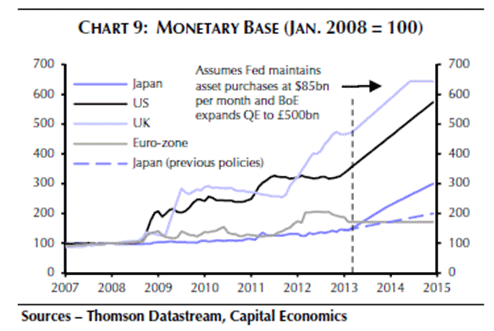
Let’s quickly review a few charts on the history of the yen. The first is the yen against the US dollar since 1990. Yes, the yen has fallen 35% or so against the dollar in its recent move, but it must fall another 20 yen to get back to where it was just six years ago. It traded at over 350 yen to the dollar when I was in school, back in the Dark Ages. The yen's four-decade appreciation of some 470% against the dollar puts the recent move of less than 25 yen into historical perspective.
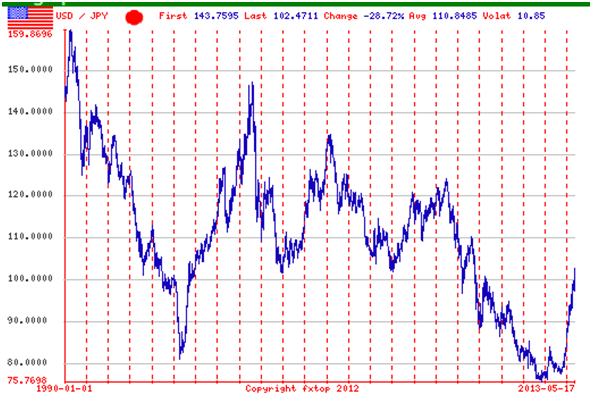
The team at Mauldin Economics, writing in Just One Trade this week, sent out this note:
Let's put the recent drop in the yen in context. The Nihon Keizai Shimbun, the main Japanese business newspaper, has reported that every one-yen fall in the yen/dollar rate will translate into a $2.7 BILLION increase in profits for the 30 largest Japanese exporters.

For every one yen the currency drops in value against the dollar, Toyota estimates that its profits will increase by $340 million. PER ONE-YEN DROP! Toyota reported $3.33 billion in profits last quarter, so that additional $340 million of profit per one-yen fall could send its second-half profits – and its stock – to the moon.
But those profits don’t just magically appear; they come from sales. Sales that are in large part due to better terms of trade and lower costs. Those profits are from sales that might have gone to other companies based in other countries and that might have been valued in euros, dollars, yuan, or won. Which is why businesses and finance ministers all over the world are not happy with Japan.
A rather useful analysis of the competitive relationships between Japan and its Asian neighbors was recently published by Charlie Lay at Commerzbank . In it he has a chart from IMF data that examines export similarity with Japan. Germany is the country whose exports are most similar to Japan's, followed by Korea and Taiwan, then the US, UK, and France.
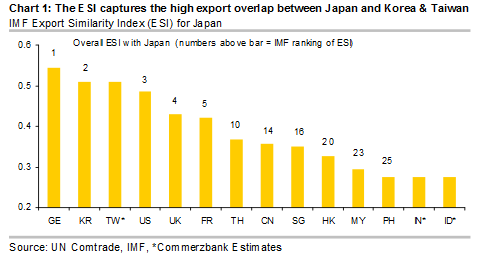
China is becoming an ever larger part of global trade as the country continues to develop. And who exports the most to them? Japan, of course, and Japan competes directly with Korea, Hong Kong, and Taiwan for that business.

Profits in companies in Korea, Hong Kong, and Taiwan are getting hammered, as those companies have to lower prices to compete with resurgent Japanese firms. While the government of Japan will never publicly admit it, it will not be long until the yen is at 120 and then moving even higher, although the road to enyasu will get bumpier as the yen falls ever more and other countries respond. Japanese monetary policy is almost irrevocably committed to continuing to devalue the yen for a very long time at what will be an ever-increasing rate.
The next chart shows the euro-yen rate over the last 23 years. If the yen moves back to where it was just six years ago, Germany et al. are in deep schnitzel as far as their export trade is concerned.
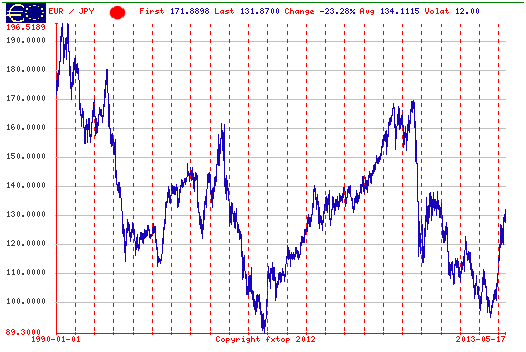
Go back up to the chart that compares monetary bases. That will help you understand the muted response of the US and the UK to Japan's moves. We have heard from EU ministers, notably in Germany, who are very vocal in complaining about Japan. The ECB has an inflation mandate that is theoretically limiting them from quantitative easing on the scale of the US, UK, or Japan. I say theoretically because, when Germany joins France in a serious recession that is due in part to "currency tensions" (or at least that is where the finger will be pointed, because gods forbid we blame our own policies), I fully expect those very creative people at the European Central Bank to come up with a “legal” way to join the QE party. And everyone knows that when Draghi decides to stir things up, he does so with style and with a full orchestra in accompaniment. And the Bundesbank will be playing the bass fiddle and drums.
The number one export that Japan is offering is its deflation. It is trying to push deflation on every country that competes with it for trade. That is rather the point of an inflation target of 2%. It is just as if the leaders of Japan had got together and said, “We can’t seem to get rid of our deflation. Let’s see if we can export it.” Capital Economics writes this interesting note on that goal:
Is 2% inflation achievable? This doesn’t mean that inflation won’t head towards 2% soon. There were two periods when inflation topped 2% even during the lost decades – when the consumption tax was last raised in 1997 and when the costs of imported oil surged in 2008.
Indeed, we expect inflation to climb above 3% in 2014 as a result of the planned consumption tax hike next year. However, the Bank of Japan will look beyond any tax effects when gauging progress towards its inflation target. While we do expect inflation excluding tax effects to pick up as well, this would largely be a result of the pass-through of yen weakness to import costs rather than any sustained increase in underlying inflation.
And that is the problem. Japan can generate inflation if it depreciates its currency. But that inflation will have particularly harsh effects on retirees. Energy and food (which are largely imported) and any other item that needs resources not found in Japan will rise in cost as the value of the yen falls. Those living on fixed incomes will be hurt the most, and that is a very large and growing part of the population of modern Japan.
Abe’s reforms require significant economic growth. Japan has had none for two decades, and now conditions for growth are even more difficult. Growth in GDP comes from two (and only two) sources: growth in productivity and growth in (working-age) population. Japan’s population is actually shrinking, and its working-age population is falling even faster as the country rapidly ages.
Because of the demographic problems of an aging Japan, economic growth will require even greater productivity growth than normal. Where is that going to come from? Real productivity growth (as opposed to nominal growth due to inflation) is not something you can just dial up with government policies and quantitative easing. It is incremental in nature. If you want 3% GDP growth in a country whose population is shrinking by 1%, you need 4% productivity growth, give or take. That just doesn’t happen on a sustained basis in a developed country.
And even with that growth, it would not be easy to achieve 2% inflation in Japan. Roubini Global Economics noted yesterday:
However, consumer service sector price deflation, arguably the most important gauge of general price level trends, accelerated for a third straight quarter, corroborating the weak CPI data we have seen so far this year. There is still a long road to sustained positive inflation.
The first thing that jumped out at us was the negative sign in front of the private nonresidential investment growth rate. At -0.7% q/q, private investment in plants and equipment recorded a fifth straight sequential contraction, a particularly ignominious result…. Given the slack still evident in the economy through Q1 (recall that deflation worsened over the quarter), this result isn't so surprising. The pace of contraction was considerably slower than H2 2012, and we expect to see this series return to growth in Q2. Still, this persistent weakness underscores the challenges to Japan's longer-term outlook. The pace of private nonresidential investment is now more than 17% below its Q1 2008 peak. (www.roubini.com )
What is one of the primary sources of increasing productivity? It is private capital investment (and yes, government can also be a source of capital and infrastructure). And as Roubini noted, private investment fell last quarter. The growth that occurred came from currently available industrial capacity. Clearly, Abe and company have decided that the spare capacity in Japan must be utilized (which will increase productivity because of past investment) so that new investment and a new growth cycle can start.
The Hard Part: Structural Reform
But new growth will also require concerted political and structural reform, something that Japan has been reluctant to tackle in the past. They would not restructure their banks or their debt after the bubble burst in 1989, and their failure to do so has been a main cause of the economic malaise of the last 24 years. The history of Japan since 1989 has been that they avoid real reform, preferring the easier option of more government spending.
We will close with this analysis from Capital Economics:
The third arrow of Abenomics is a growth strategy based on structural reform. The challenge here will be to raise growth even though the working age population will be falling by up to 1% per year over the next ten to twenty years. The government has identified several priorities, including deregulation (with a focus on the labour market, energy sector and healthcare), reforming the corporate tax regime, and trade liberalization (notably by seeking to join the Trans-Pacific Partnership). However, the jury is still out on whether this administration will be any more successful in raising Japan’s productivity than its predecessors, which were also mostly led by the LDP. Announcing another fiscal stimulus for 2013 and persuading the Bank of Japan to loosen monetary policy were relatively easy wins.
What Could Go Wrong?
In summary, “Abenomics” surely represents the right mix of policies to tackle Japan’s problems. But at the risk of sounding perennially gloomy, there are still a number of things that could go wrong. In particular:
i. the consumption tax hikes could derail the recovery, but if they are delayed the government would lose credibility, including with the Bank of Japan;
ii. JGB yields could take off, although we are sanguine about the increases that have taken place so far;
iii. prices could rise well before wages and other incomes, depressing consumer confidence and spending power. Indeed, few households view the prospect of an end to deflation quite as positively as businesses and investors, while in Japan’s case the wealth effects from higher equity prices are relatively small;
iv. the broad money and credit aggregates could remain subdued, despite the rapid expansion of the monetary base, undermining confidence in the effectiveness of the Bank of Japan’s bold policy easing;
v. companies could still be reluctant to invest and hire in Japan itself, especially if the global backdrop deteriorates and local costs surge – the latter due in part to the slump in the value of the yen;
vi. the LDP-led government could disappoint on structural reform – again.”
In short, the Japanese government has embarked upon an economic experiment in Keynesian theory that is breathtaking in its promised scope. They are betting that they can gear up enough growth to overcome deflation and demographics, allow the country to balance its budget, find an inflation level that will allow the Japanese debt to shrink relative to GDP, make Japan even more of an export powerhouse, and increase productivity on a scale never before seen in a developed country. It leaves one to wonder whether they might not solve global warming in their spare time.
They will do all this while hoping that the rest of the world sits idly by and watches Japan take export market share through quantitative easing. Meanwhile they're picking a fight with China over islands that are basically piles of rocks, a dispute which will cost them massive amounts in lost sales, far more than the worth of the islands, even if there is substantial oil in the surrounding waters. Japan is also betting that the technology landscape in its key industries won't change the too fast. How could anything go wrong here?
We will take up next week where we leave off today, thinking about where currency valuations and bond yields in Japan can go. We do live in interesting times.
My team at Mauldin Economics is putting the final touches on a dynamite video webinar with Kyle Bass, Mohamed El-Erian, John Hussman, Barry Ritholtz, David Rosenberg, and your humble analyst. You can register here to view the event for free. We will be dissecting the "new normal" (the term Mohamed's partner Bill Gross coined in 2009 to describe the post-Great Recession economic environment). It's a strange and uncertain world where the US stock market takes off even as economic growth slows down. A world where “safe” assets are risky. A world where investors have more information but less insight about what it means for their portfolios.
Investing In the New Normal will be a unique event with insights and actionable intelligence from some of the most respected investors and economists in the world. These are the guys I turn to when I need answers.
Tulsa, Atlanta, Nashville, Brussels, Washington DC, and NYC
As you read this I am in Tulsa, getting ready to “give away” (what a charming, ironic anachronism: daughters, at least the ones I am familiar with, are very much their own persons and tell Dad who will do what giving, where, and when) Abigail Joy. It seems like only a few years ago that we went to the Dallas Airport and met Abigail and her twin sister Amanda coming off a plane from Korea at six months old. Has it been 26 years? Who is in charge of making time pass so fast?
Even at six months old they were still tiny. They were smaller at six months than their older sisters (my biological daughters) were at birth. Amanda’s new baby Addison (six weeks) is similarly small now, even though the father is rather large.
I embarrass the twins sometimes by telling the story of the first pictures we had of them from Korea. To say they were not pretty babies at a few weeks old is being charitable, but maybe it was the photographer. When they came off the plane, they were indeed beautiful. They made the cover of Twins magazine at two. Fast-forward 17 years later, and I am escorting my daughters onto the stage at a high school homecoming event. They have both been chosen for the court. They are in their fancy gowns and are now gorgeous. Amanda was chosen as the senior on the homecoming court, and her sister was so happy for her. But I will never forget the look of pure love on Amanda’s face when she looked on as Abigail was surprisingly chosen as homecoming queen over the girl who everyone assumed would be chosen. That is one of my all-time favorite pictures. They are so close still, and I have never seen anything but love between them. That is really the only way to describ e it.
And now someone else gets to share love. I think Stephen realizes what he is getting, but I already know.
I will return home for a few days of meetings, reading, and writing (what else?) and then I'm off to Atlanta for a board meeting of a biotech company I am involved with, Galectin Therapeutics. I am looking forward to the updates from the scientists and the exchange of new ideas. There is just so much that’s positive going on in the world that it frustrates me that we have to pay attention to annoyances like QE. Then I'll scoot over to Nashville for a speech and dinner with the team at Altegris for our clients and prospects, and then be back home for a night before heading to Brussels for a speech and a series of what look to be very interesting meetings arranged by Geert Wellens. I expect to learn a lot and will report back.
After all that, I'm home for a few days before I head off to DC to meet with Newt Gingrich, who said some very kind words about me this week. We share a mutual love of thinking about technology, change, and the future. Pat Cox and some of my team are going to join us for a day or so of musing about how the world will change. Then I'll catch a train with John Hussman and we'll go to NYC.
As you can tell, life is busy, but I am having fun exploring all sorts of new ideas and trying to figure out how all the puzzle pieces fit together. How can anyone get bored these days? Enjoy your week. Mine will be marvelous as all the family gathers in Tulsa. I even think we will sneak in some guy time to go see the new Star Trek movie. I am still such a geek. Live Long and Prosper!
Your will not cry at weddings analyst,
John Mauldin
subscribers@MauldinEconomics.com
Outside the Box is a free weekly economic e-letter by best-selling author and renowned financial expert, John Mauldin. You can learn more and get your free subscription by visiting www.JohnMauldin.com.
Please write to johnmauldin@2000wave.com to inform us of any reproductions, including when and where copy will be reproduced. You must keep the letter intact, from introduction to disclaimers. If you would like to quote brief portions only, please reference www.JohnMauldin.com.
John Mauldin, Best-Selling author and recognized financial expert, is also editor of the free Thoughts From the Frontline that goes to over 1 million readers each week. For more information on John or his FREE weekly economic letter go to: http://www.frontlinethoughts.com/
To subscribe to John Mauldin's E-Letter please click here:http://www.frontlinethoughts.com/subscribe.asp
Copyright 2013 John Mauldin. All Rights Reserved
Note: John Mauldin is the President of Millennium Wave Advisors, LLC (MWA), which is an investment advisory firm registered with multiple states. John Mauldin is a registered representative of Millennium Wave Securities, LLC, (MWS), an FINRA registered broker-dealer. MWS is also a Commodity Pool Operator (CPO) and a Commodity Trading Advisor (CTA) registered with the CFTC, as well as an Introducing Broker (IB). Millennium Wave Investments is a dba of MWA LLC and MWS LLC. Millennium Wave Investments cooperates in the consulting on and marketing of private investment offerings with other independent firms such as Altegris Investments; Absolute Return Partners, LLP; Plexus Asset Management; Fynn Capital; and Nicola Wealth Management. Funds recommended by Mauldin may pay a portion of their fees to these independent firms, who will share 1/3 of those fees with MWS and thus with Mauldin. Any views expressed herein are provided for information purposes only and should not be construed in any way as an offer, an endorsement, or inducement to invest with any CTA, fund, or program mentioned here or elsewhere. Before seeking any advisor's services or making an investment in a fund, investors must read and examine thoroughly the respective disclosure document or offering memorandum. Since these firms and Mauldin receive fees from the funds they recommend/market, they only recommend/market products with which they have been able to negotiate fee arrangements.
Opinions expressed in these reports may change without prior notice. John Mauldin and/or the staffs at Millennium Wave Advisors, LLC and InvestorsInsight Publishing, Inc. ("InvestorsInsight") may or may not have investments in any funds cited above.
Disclaimer PAST RESULTS ARE NOT INDICATIVE OF FUTURE RESULTS. THERE IS RISK OF LOSS AS WELL AS THE OPPORTUNITY FOR GAIN WHEN INVESTING IN MANAGED FUNDS. WHEN CONSIDERING ALTERNATIVE INVESTMENTS, INCLUDING HEDGE FUNDS, YOU SHOULD CONSIDER VARIOUS RISKS INCLUDING THE FACT THAT SOME PRODUCTS: OFTEN ENGAGE IN LEVERAGING AND OTHER SPECULATIVE INVESTMENT PRACTICES THAT MAY INCREASE THE RISK OF INVESTMENT LOSS, CAN BE ILLIQUID, ARE NOT REQUIRED TO PROVIDE PERIODIC PRICING OR VALUATION INFORMATION TO INVESTORS, MAY INVOLVE COMPLEX TAX STRUCTURES AND DELAYS IN DISTRIBUTING IMPORTANT TAX INFORMATION, ARE NOT SUBJECT TO THE SAME REGULATORY REQUIREMENTS AS MUTUAL FUNDS, OFTEN CHARGE HIGH FEES, AND IN MANY CASES THE UNDERLYING INVESTMENTS ARE NOT TRANSPARENT AND ARE KNOWN ONLY TO THE INVESTMENT MANAGER.
John Mauldin Archive |
© 2005-2022 http://www.MarketOracle.co.uk - The Market Oracle is a FREE Daily Financial Markets Analysis & Forecasting online publication.



